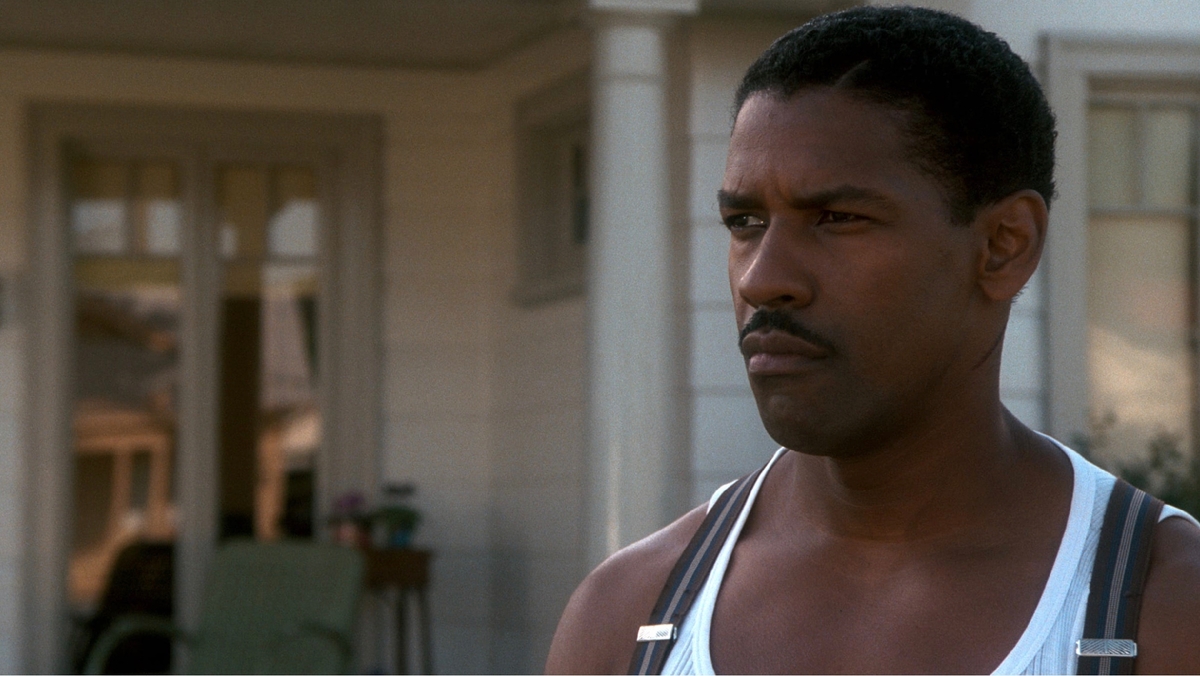
Denzel Washington in Devil in a Blue Dress.
Ezekiel “Easy” Rawlins is going through a hard patch. He’s just lost his job and he’s got bills to pay. He’s looking through the classified ads at the bar of a friend of his, Joppy, when a shifty-looking White man with a thin mustache comes in offering work. Easy asks him what kind of work he does.
“I do favors,” the man said. “I do favors for friends.”
Easy isn’t convinced. Joppy tries to be reassuring. “Ain’t nothing to worry about,” he said. That’s when Easy’s voiceover comes in, telling us how he feels. When someone tells me ain’t nothing to worry about, I usually look down to see if my fly’s open. But on the way home, all I could think about was the chance to make some money.
That’s how the problems start rolling in Devil in a Blue Dress, the 1995 neo-noir thriller directed by Carl Franklin, adapted from the novel by Walter Mosley, and starring Denzel Washington, Jennifer Beals, Don Cheadle, and Tom Sizemore. The movie is the second entry in Best Video Film and Cultural Center’s Neo-Noirvember Series, the latest in its themed monthly screening series. The series continues next week, Nov. 21, with 1996’s Bound and concludes the week after, Nov. 28, with 1967’s Le Samouraï.
Teo Hernandez, an archive staffer who also works with production and programming at Best Video, explained that the theme for November came from former Best Video staffer Jules Larson. “She would always, for November, only watch noir, and called it Noirvember,” Hernandez said. The genre seemed to fit the darkening month of November the same way horror movies fit for October. And “the films we picked for this month are pretty underseen.” Quentin Tarantino’s Jackie Brown, which started the series last week, might be the most popular movie for the month. Bound is perhaps inexplicably less seen, given that the Wachowskis, who wrote and directed it, went on to make 1999’s The Matrix.
Mentioning the “ongoing argument” over whether noir is “a genre or just a style of filmmaking,” Hernandez observed that the 1990s saw a resurgence in interest in it, with smashes like The Usual Suspects, LA Confidential, and Seven really being among a pack of movies in the decade to soak in noir’s world of convoluted plots, hard-bitten men, femmes fatale, luscious scenery, and tricky camerawork. “I thought it’d be great to put together movies that people don’t necessarily talk about,” Hernandez said.
Devil in a Blue Dress is a perfect case in point. It begins with celebrated mystery writer Walter Mosley, who wrote the novel and produced the film, and proceeds to Carl Franklin’s skillful adaptation, which keeps the plot’s twists and turns on track by never forgetting that, in the end, the story is pretty simple — it’s about a bunch of men all trying to find the same woman — even as the crimes (and bodies) pile up, and the reason for all the carnage eventually becomes grimly clear. In atmosphere, the movie is in some ways a throwback to a throwback in the best sense, as it’s a movie made in the 1990s that is set in the 1950s, with all the attention to costume and set detail that requires. The camera luxuriates in the shapes and colors of Los Angeles, drenching some scenes in a seedy glitziness, others in straight-up seediness, and still others in a summery glow (which we’ll get to in a minute).
It features several standout performances as well. A young Denzel Washington slays as the brave (or is it brash?) Easy, first as a man trying to stay out of trouble, and eventually as a man all too willing to stir up some of his own. Jennifer Beals as the femme fatale object of everyone’s desires exudes strength, cunning, and vulnerability. Tom Sizemore is at his sleaziest as a cheap, ruthless criminal. The real show stealer, though, is Don Cheadle, as Easy’s acquaintance Mouse, whose cavalier approach to violence somehow manages to be hilarious, charming, and startling. The scenes between Washington and Cheadle sparkle with chemistry, two actors energizing one another to make the movie as fun and thrilling as it can be.
Like some of the best mysteries out there, Devil in a Blue Dress also turns out to have some shrewd observations to make about race in Los Angeles: the things White people can get away with that Black people can’t; the things Black people know deeply that White people will never really understand; and the way that the divides between Black and White hurt everyone. It’s all baked into the story in a seamless way, explaining character motivations, driving plot, and determining where everyone finds themselves in the end. The cherry on top, meanwhile, is the movie’s loving evocation of a Black neighborhood in Los Angeles in the 1950s. We see people struggling to make ends meet, people who give up and move someplace cheaper. But we also see camaraderie, community spirit, and just plain old fun, too. It gives the thriller some real depth that also feels effortless in a way that can elude more serious movies. You start watching Devil in a Blue Dress for the charm and the sexiness. You finish it with a richer understanding of the ways that, even with the cards stacked against them, people can still get by.
Like Easy asks an acquaintance near the movie’s end, “if you got a friend that you know does bad things — real bad things — and you still keep him as a friend even though you know what he’s like, do you think that’s wrong?”
The acquaintance gives Easy a long, meaningful look. “All you got is your friends,” he says.
The Neo-Noirvember series continues on Nov. 21 and Nov. 28, at Best Video Film and Cultural Center, 1842 Whitney Ave. in Hamden. Visit Best Video’s website for more information.


Easy Rawlings. Great character.